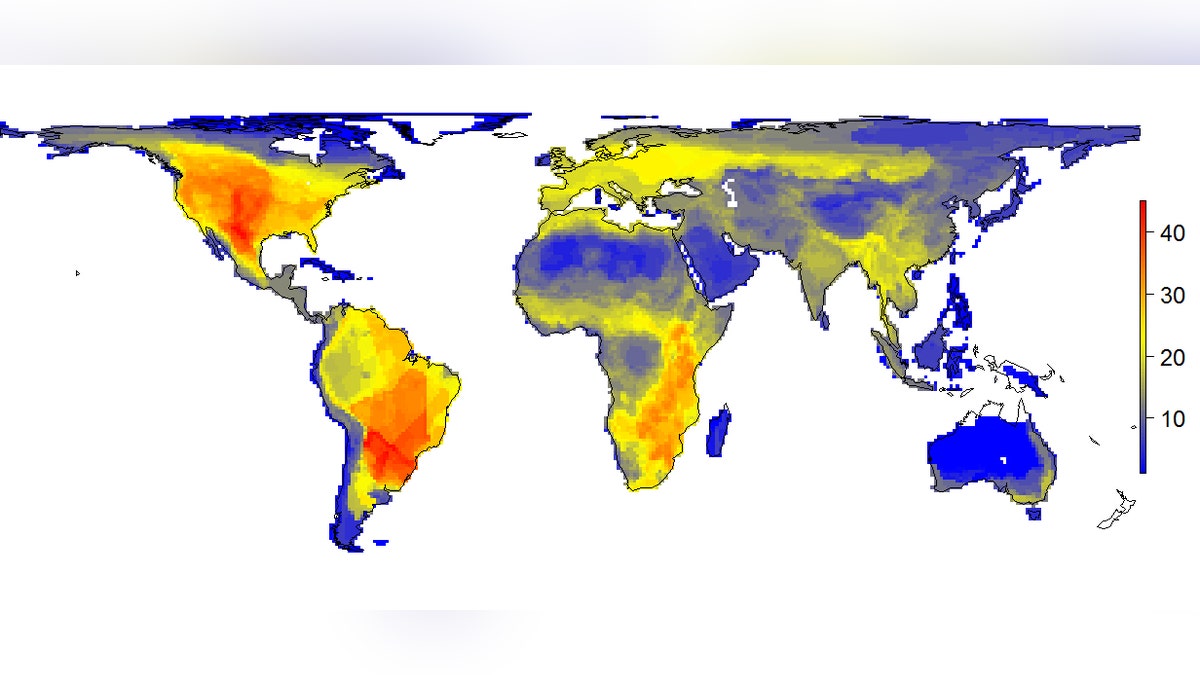
This map depicts the diversity of large mammals globally today. (Soren Faurby)
If humans never existed, lions, saber–tooth tigers, 330–pound beavers and house-sized armadillos would be walking around Texas right now. A new study from researchers at Aarhus University demonstrates what the world would look like for mammals if the most destructive super predator of them all — Homo sapiens — had never been around.
The study was born out of the team’s previous research, which found that a lot of mammal species that went extinct during the last Ice Age was mostly due to the spread of humans rather than climate change.
“Last year we published another study, which along other studies, clearly suggested that humans were a massive driver in the large extinction which occurred near the end of the last ice age,” lead study author and postdoctoral fellow in bioscience Soren Faurby told Foxnews.com. “During this work we started talking about just how big the effects of humans was and how the world would have been different if humans had not influenced the distribution of any species within the last 130,000 years and I started estimating this by generating attempts of so–called present-natural distributions of all mammalian species, meaning where they potentially could have been today.”
According to the study, rhinos and elephants would thrive alongside bears and Eurasian elk in Europe, while American lions and camels (among other things) would be prowling around North America.
“Texas and Mexico would likely naturally have some of the highest diversity,” Faurby suggested. “Among the extinct North American species [that would be alive today] are Short–faced bears, American lions, saber–tooth cats, Dire wolfs, giant ground sloths, mastodons, mammoths, camels, giant beavers (330 pounds or so), tapirs, and glyptodonts (house sizes armadillo relatives).”

The diversity of large mammals if humans never existed. (Soren Faurby)
Along with mapping out the current patterns of mammal diversity, the researchers had to use historic sources to determine how some species were distributed — for instance, what the Europeans saw when they first came to North America. However, for species that went extinct when the last Ice Age ended this wasn’t possible due to both the limited data available and the climate today being so different that the species wouldn’t be in the same location geographically.
“For these species we instead estimated the potential range based on the current ranges of the species [they] used to co-occur with,” Faurby told Foxnews.com. “The extinct elephant (Straight tusked elephant, Elephas antiquus) and extinct rhinos (two species of Stephanorhinus) used to co–occur with species currently widely distributed in Northern Europe and it is therefore likely that this elephant and rhino would be found in the same overall places without human involvement.”
Today, sub–Saharan Africa has the greatest diversity of big mammal species and is in many ways the last refuge for them, with the Serengeti being one of the last places on Earth to see such a large diversity.
“Some of it is because Africa had a low extinction near the end of the last ice age which we and others have interpreted as being a consequence of co-evolution,” he said. “The African mammals had a long time to adapt to a slowly better hunter (Homo sapiens) whereas the fauna of America and Australia had never met any carnivore similar to the modern humans hunting with spears.”
Faurby also noted that there may be an element of parasitism at play — since the human genus evolved in Africa, many parasites are likewise found there. The Tsetse flies in particular may have had an effect as they’ve made some parts uninhabitable for humans.
The study was published August 20th in Diversity and Distributions.




















